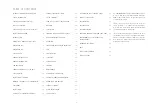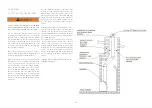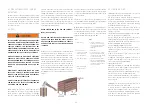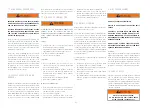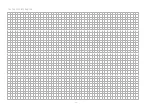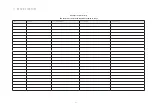
14
4.6 MASONRY
4.6.1 TYPICAL EXISTING MASONRY
WARNING
DO NOT CONNECT THIS APPLIANCE TO A CHIMNEY
FLUE SERVING ANOTHER FIREPLACE. DO NOT CON-
NECT TO ANY AIR DISTRIBUTION DUCT OR SYSTEM.
You can install your masonry inserts using your
existing masonry chimney liner. To do so, follow the
guidelines below. If you are using a masonry chimney,
it is important that it be built in compliance with the
specifications of the Building Code in your region. It
must normally be lined with refractory bricks, metal
or clay tiles sealed together with fire cement. (Round
flues are the most efficient).
Remove the wood insert damper or fasten it perma-
nently open. We recommend the following method of
sealing off the damper area around the liner:
Measure the throat of the wood insert and mark
this shape on a piece of 24 gauge sheet metal (flue
cover); cut a six-inch (6 3/4” / 171mm) hole to lie
directly below the wood insert flue opening. Allow two
inches of material for a flange on all sides and cut to
these measurements. Bend down the flanges. If you
have never done this before, it might be a good idea
to make a cardboard pattern and test it first. Fasten
this flue cover in position as high as possible with two
masonry screws per side through the flanges into the
wood insert.
I
n Canada: Install only flexible or solid chimney liner
from the top of the chimney to the insert flue collar.
Attach a stainless steel liner connector or elbow to the
liner and insert onto the flue collar. Fasten with three
screws. Secure the top of the liner to the chimney cap
using a liner support and chimney flashing. Cap the
top of the chimney liner assembly using an approved
rain cap.
In the United States: While it is not required, it is rec-
ommended that a chimney liner be installed that is
continuous from the insert to the top of the chimney,
particularly when the insert is installed in a basement.
For this type of connection, use the “In Canada” instal-
lation instructions above.
If a continuous liner is not installed, a “direct flue
connection” must be made. The direct flue connection
requires a non-combustible connector that extends
from the insert into the chimney flue liner and also the
installed flue cover to be sealed below the entry point
of the connector to prevent dilution of combustion
products in the chimney flue with air from inside the
house. Cap the top of the chimney using an approved
rain cap.
THIS UNIT IS NOT TESTED TO BE BUILT INTO A FAC-
TORY BUILT FIREPLACE.
Summary of Contents for Insert-600
Page 26: ...26 10 6 FOR YOUR INFORMATION...



